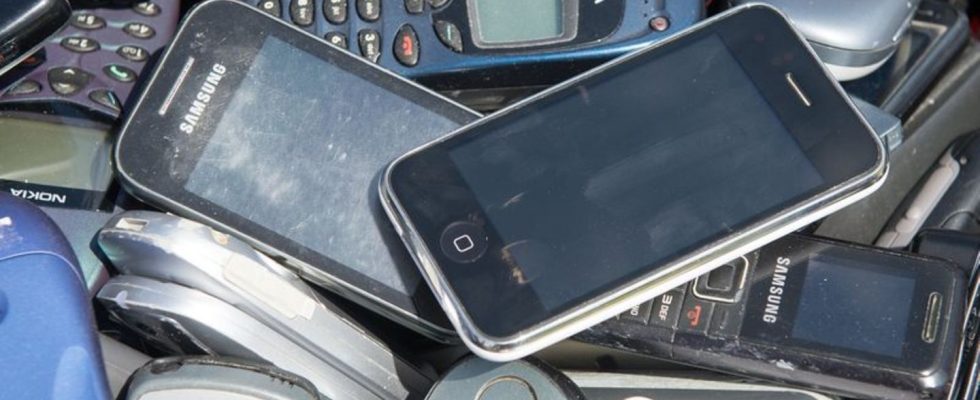The mountain of discarded electronic waste grows and grows. But so far only a small portion of the valuable raw materials in it have been recovered.
According to a new UN report, more and more electronic waste is being produced worldwide – and recycling is not keeping up. In 2022 alone, 62 million tons of electronic waste were generated, according to the “Global E-Waste Monitor” published on Wednesday. That is a record – and an increase of 82 percent compared to 2010. If things continue like this, 82 million tons can be expected in 2030. E-waste includes everything that has a plug or a battery.
The authors of the report choose impressive comparisons to illustrate the extent of the global scrap problem: The electronic waste from 2022 could fill 1.55 million 40-ton trucks, they write. The column of trucks would then extend bumper to bumper roughly around the equator.
Hardly any recycling
The problem: In relation to the rapidly growing mountain of discarded cell phones, laptops, televisions, refrigerators and other devices, documented recycling is lagging behind. In 2022, less than a quarter (22.3 percent) of electronic waste was demonstrably collected and processed properly, it said. By 2030, the value could fall to 20 percent. Billions of dollars worth of recoverable resources would be wasted. There are also dangers for the environment – electronic waste can contain toxic additives and dangerous substances such as mercury. It should therefore be disposed of and processed in the correct way.
“We are dealing with a very massive imbalance,” said Rüdiger Kühr, one of the authors, to the German Press Agency. “This is largely due to the fact that in many parts of the world there is neither appropriate legislation nor infrastructure for collection and recycling. This means that the materials do not enter the actual recycling process.” At the same time, there is an enormous increase in electronic devices in many regions. Much more is coming onto the market than can currently be collected and recycled.
Example e-cigarettes
“For example, there are e-cigarettes. Or smart clothing that is becoming en vogue – for example with a built-in heating function,” Kühr listed. Even children’s toys often only work with a battery or a plug.
There are many reasons why what were once new, beautiful products soon become scrap. One of them: repairs are often extremely difficult. This is also due to the design of the devices. Many are glued instead of screwed, making them difficult to open without damage. “That also has something to do with the costs,” explained Kühr. “An intelligent screw connection is more cost-intensive to produce than gluing.” There has to be a rethink. “Repairability needs to be made easier.”
A third small appliances
According to the authors’ estimates, around a third of global electronic waste in 2022 consisted of small devices such as toys, microwave ovens or e-cigarettes. The documented recycling rates for this equipment are still very low (12 percent). Discarded large appliances such as refrigerators or washing machines are more often properly processed.
In many cases, however, there is simply a lack of knowledge about what to do with all the electrical equipment when it no longer works – or convenience takes over. An estimated 14 million tons of electronic waste simply ended up in normal trash cans in 2022, the report says.
“The biggest problem worldwide and in all countries is the entry of electronic waste into municipal waste that is landfilled or incinerated,” explained Christoph Helbig from the University of Bayreuth, who was not involved in the report. Electrical appliances should never be placed in the normal household waste bin – municipalities are asked to create good, low-threshold return options.
What to do with old devices?
“Many people simply don’t know what to do with discarded electronic devices,” said Vanessa Gray, who also contributed to the report. Some people are also afraid that an old phone still contains sensitive data. “It’s also about creating awareness of this problem.” But she also emphasized: “The simplest solution to all e-waste problems is not to produce e-waste at all.”
Per capita, Europeans lead the way in electronic waste generation with 17.6 kilograms, followed by Oceania (16.1 kilograms) and America (14.1 kilograms). At the same time, these regions have the highest recycling rates – the Europeans, for example, have 42.8 percent. In Africa, much less electronic waste is generated per capita (2.5 kilograms) – but less than 1 percent is proven to be properly collected and recycled there.
“In Germany, too, the situation is still unsatisfactory and the EU requirements for the collection of old devices are missed by more than 20 percent every year,” emphasized Andreas Manhart from the Öko-Institut in Freiburg, who was not involved in the report. “As a result, we lose several hundred thousand tons of raw materials every year.” The materials included include copper, iron, gold, nickel and aluminum.
The “Global E-Waste Monitor” is presented regularly and can therefore compare figures and data from different years. The authors are the United Nations Training and Research Institute (UNITAR) and the International Telecommunications Union (ITU).
Digitization requires material
The authors also look to the future. “We have to see clearly: digitalization requires more electronic items and critical raw materials,” said Vanessa Gray. “We know, for example, that a third of the world’s population is not yet connected to the Internet. If we want these people to participate in digitalization over the next few years, we need a lot of material,” she said. “This will of course also lead to more electronic waste.”

